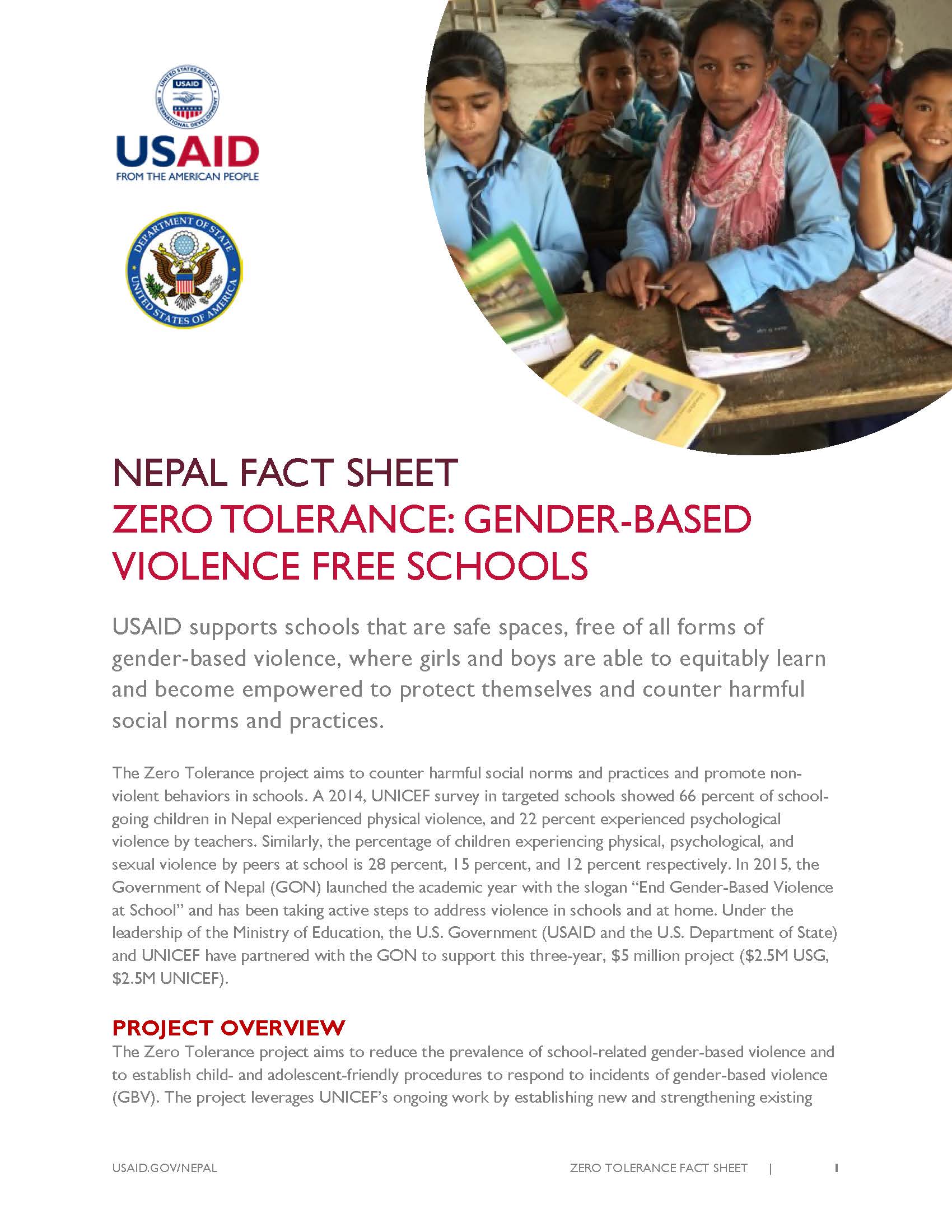USAID supports schools that are safe spaces, free of all forms of gender-based violence, where girls and boys are able to equitably learn and become empowered to protect themselves and counter harmful social norms and practices.
ZERO TOLERANCE: GENDER-BASED VIOLENCE FREE SCHOOLS ![]() (pdf - 185k)
(pdf - 185k)
The Zero Tolerance project aims to counter harmful social norms and practices and promote nonviolent behaviors in schools. A 2014, UNICEF survey in targeted schools showed 66 percent of schoolgoing children in Nepal experienced physical violence, and 22 percent experienced psychological violence by teachers. Similarly, the percentage of children experiencing physical, psychological, and sexual violence by peers at school is 28 percent, 15 percent, and 12 percent respectively. In 2015, the Government of Nepal (GON) launched the academic year with the slogan “End Gender-Based Violence at School” and has been taking active steps to address violence in schools and at home. Under the leadership of the Ministry of Education, the U.S. Government (USAID and the U.S. Department of State) and UNICEF have partnered with the GON to support this three-year, $5 million project ($2.5M USG, $2.5M UNICEF).
PROJECT OVERVIEW
The Zero Tolerance project aims to reduce the prevalence of school-related gender-based violence and to establish child- and adolescent-friendly procedures to respond to incidents of gender-based violence (GBV). The project leverages UNICEF’s ongoing work by establishing new and strengthening existing connections between schools and child protection actors. Through training, mapping of services for GBV survivors and advocacy and awareness raising activities, school actors will gain knowledge of child rights, as well as a better understanding of the impact of GBV – including segregation during menstruation (or chhaupadi) and child marriage. To complement GBV-prevention activities, the project will also develop a systematic reporting and referral mechanism to monitor and respond to incidents of school-related GBV. Such activities will ensure that students who are victims or at-risk of violence are appropriately supported and have access to child- and adolescent-friendly services.
PLANNED ACTIVITIES
Outcome 1: Schools, communities, boys, and girls promote nonviolent behaviors and zero tolerance of GBV in schools
- Train teachers, school management committees (SMCs), parent-teacher associations (PTAs), and young champions on GBV prevention.
- Conduct advocacy and awareness raising events in schools and communities.
Outcome 2: Students, teachers, and school staff confidently report cases of violence
- Design and pilot a school-based reporting and referral mechanism.
- Create new and strengthen existing linkages between schools, service providers, and community-based intervention mechanisms.
Outcome 3: Boys and girls who are victims or at risk of violence in the school and in the community have access to child- and adolescent-friendly services
- Strengthen school and justice sector capacity to provide child- and adolescent-friendly gendersensitive services.
- Provide effective case management, outreach, support, and follow-up services to GBV survivors and their families.
EXPECTED RESULTS
- Students feel safe in schools and communities.
- Project beneficiaries view GBV as less acceptable.
- Targeted populations increasingly agree that both genders deserve equal access to social, economic, and political opportunities.
- Teachers, school management committees, and PTAs have comprehensive GBV knowledge (impact, legal aspects, case management guidelines, and referral mechanisms).
- Schools report GBV cases (including school-related GBV, chhaupadi, and child marriage) to authorities.
- Students and families view service providers as child- and adolescent-friendly.
- Students access child and adolescent-friendly services.
PROJECT TARGETS
- 200 schools across the four districts (Parsa, Dhanusha, Mahottari, and Rautahat), reaching approximately 100,000 learners, 2,000 teachers, and 5,000 school management committee and PTA members.
- Approximately 1,000 children reached through family support and other services.








Comment
Make a general inquiry or suggest an improvement.